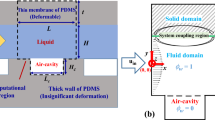Abstract
Recent developments in superhydrophobic surfaces have enabled significant reduction in the frictional drag for liquid flow through microchannels. There is an apparent risk when using such surfaces, however, that under some conditions the liquid meniscus may destabilize and, consequently, the liquid will wet the entire patterned surface. This paper presents analytical and experimental results that compare the laminar flow dynamics through microchannels with superhydrophobic walls featuring ribs and cavities oriented both parallel and transverse to the direction of flow under both wetting and non-wetting conditions. The results show the reduction in the total frictional resistance is much greater in channels when the liquid phase does not enter the cavity regions. Further, it is demonstrated that the wetting and non-wetting cavity results represent limiting cases between which the experimental data lie. Generalized expressions enabling prediction of the classical friction factor-Reynolds number product as a function of the relevant governing dimensionless parameters are also presented for both the superhydrophobic and wetting states. Experimental results are presented for a range of parameters in the laminar flow regime.












Similar content being viewed by others
References
Bico J, Thiele U, Quere D (2002) Wetting of textured surfaces. Colloids Surf A 206:41–46
Chen W, Fadeev AY, Hsieh MC, Oner D, Youngblood J, McCarthy TJ (1999) Ultrahydrophobic and ultralyophobic surfaces: some comments and examples. Langmuir 15:3395–3399
Choi C-H, Umberto U, Joonwon K, Chih-Ming H, Chang-Jin K (2006) Effective slip and friction reduction in nanograted superhydrophobic microchannels. Phys Fluids 18:087105
Davies J (2006) Analysis of viscous drag reduction and thermal transport effects for microengineered ultrahydrophobic surfaces. M.S. thesis, Brigham Young University
Davies J, Maynes D, Webb BW, Woolford B (2006) Laminar flow in a microchannel with super-hydrophobic walls exhibiting transverse ribs. Phys Fluids 18:087110
Enright R, Eason C, Dalton T and Salamon T (2007) Transport in superhydrohobic microchannles: a porous modeling approach. In: Proceedings of the 2007 ASME–JSME thermal eng. heat transfer conference, BC, Canada
Enright R, Dalton T, Krupenkin TN, Kolodner P, Hodes M, and Salamon T (2008) Effects of interfacial position on drag reduction in a superhydrophobic channel. In: Proceedings of the ICNMM2008, Darmstadt, Germany
Fox RW, McDonald AT, Pritchard PJ (2004) Introduction to fluid mechanics, 6th edn. Wiley, Hoboken
Kim J and Kim CJ (2002) Nanostructured surfaces for dramatic reduction of flow resistance in droplet-based microfluidics. In: Proceedings of the IEEE MEMS 2002 Conference, Las Vegas, NV, 479–482
Lau KKS, Bico J, Teo KBK, Chhowalla M, Amaratunga GAJ, Milne WI, McKinley GH, Gleason KK (2003) Superhydrophobic carbon nanotube forests. Nanoletters 3:1701–1705
Lauga E, Stone H (2003) Effective slip in pressure-driven stokes flow. J Fluid Mech 489:55–77
Lee C, Choi CH, Kim CJ (2008) Structured surfaces for giant liquid slip. Phys Rev Lett 101:064501
Lobaton EJ, Salamon TR (2007) Computation of constant mean curvature surfaces: application to the gas-liquid interface of a pressurized fluid on a superhydrophobic surface. J Colloid Int Sci 314:184–198
Maynes D, Jeffs K, Woolford B, Webb BW (2007) Laminar flow in a microchannel with hydrophobic surface patterned micro-ribs oriented parallel to the flow direction. Phys Fluids 19:093606
Oner D, McCarthy TJ (2000) Ultrahydrophobic surfaces. effects of topography length scales on wettability. Langmuir 16:7777–7782
Ou J, Rothstein JP (2005) Direct velocity measurements of the flow past drag-reducing ultrahydrophobic surfaces. Phys Fluids 17:103606
Ou J, Perot B, Rothstein JP (2004) Laminar drag reduction in microchannels using ultrahydrophobic surfaces. Phys of Fluids 16:4635–4643
Philip JR (1972) Flows satisfying mixed no-slip and no-shear conditions. J App Math Phys 23:353–371
Rioboo R, Marengo M, Tropea C (2002) Time evolution of liquid drop impact on solid, dry surfaces. Exp Fluids 35:648–652
Salamon T, Lee W, Krupenkin T, Hodes M, and Kolodner P (2005) Numerical simulation of fluid flow in microchannels with superhydrophobic walls. In: Proceedings of the ASME IMECE2005, Orlando, FL
Sbragaglia M, Prosperetti A (2007) A note on the effective slip properties for microchannel flows with ultrahydrophobic surfaces. Phys Fluids 19:043603
Torkkeli A, Saarilahti J, Haara A, Harma H, Soukka T, and Tolonen P (2001) Electrostatic transportation of water droplets on superhydrophobic surfaces. In: Proceedings IEEE MEMS 2001 conference 475–478
Wang CY (2003) Flow over a surface with parallel grooves. Phys Fluids 15:1114–1121
Watanabe K, Udagawa Y, Udagawa H (1999) Drag reduction of newtonion fluid in a circular pipe with a highly water-repellent wall. J Fluid Mech 381:225
Weast RC, Astle MJ (1982) CRC handbook of chemistry and physics, 63rd edn. CRC Press, Boca Raton
White FM (2006) Viscous fluid flow, 3rd edn. McGraw-Hill, New York
Woolford B, Jeffs K, Maynes D, and Webb BW (2005) Laminar fully-developed flow in a microchannel with patterned ultrahydrophobic walls. In: Proceedings of the ASME Summer Heat Tran. Conference, HT2005–72726, ASME, New York
Ybert C, Barentin C, Cottin-Bizonne C, Joseph P, Bocquet L (2007) Achieving large slip with superhydrophobic surfaces: scaling laws for generic geometries. Phys of Fluids 19:123601
Author information
Authors and Affiliations
Corresponding author
Rights and permissions
About this article
Cite this article
Woolford, B., Maynes, D. & Webb, B.W. Liquid flow through microchannels with grooved walls under wetting and superhydrophobic conditions. Microfluid Nanofluid 7, 121–135 (2009). https://doi.org/10.1007/s10404-008-0365-6
Received:
Accepted:
Published:
Issue Date:
DOI: https://doi.org/10.1007/s10404-008-0365-6




